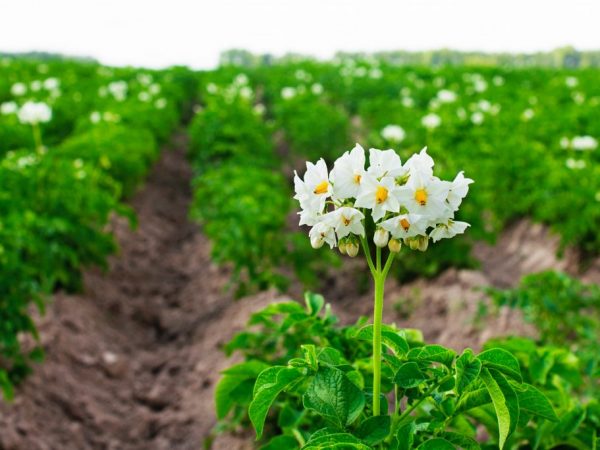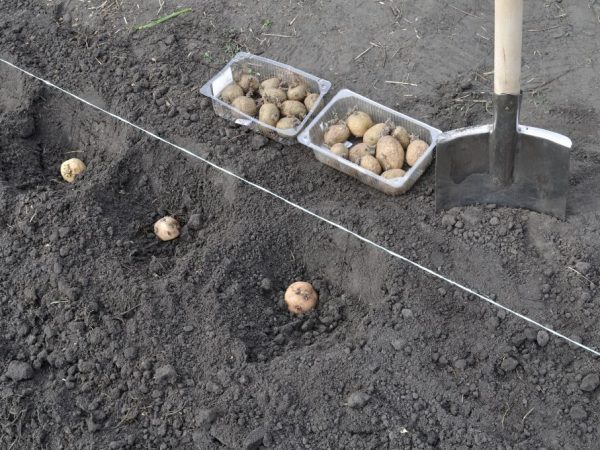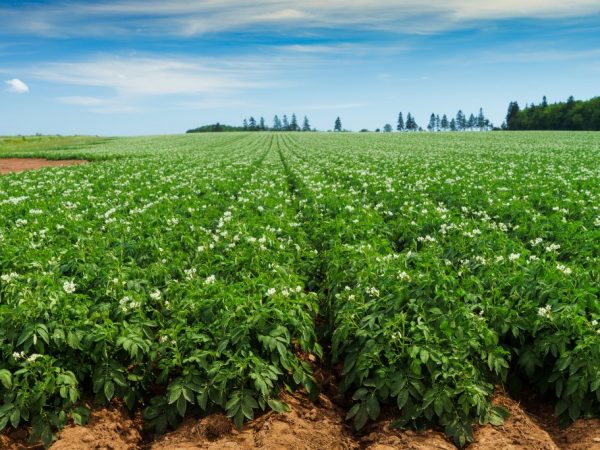Rules for growing potatoes in the open field
Growing potatoes outdoors requires the right approach. Many will say that this is all a waste of time. But, with proper care, regular fertilization, the right choice of planting method and timing, the yield doubles.

Rules for growing potatoes in the open field
Soil preparation
For many varieties of potatoes, the composition of the soil is not fundamental, but the culture grows best on loamy and sandy loam soils. Any soil before planting potatoes must undergo special treatment. They begin to prepare the soil in the fall, after harvesting the entire crop.
It is not recommended to plant potatoes in the same place for several years in a row. If it is not possible to change the territory for planting, you should plant siderat plants on it. These include:
- radish;
- linen;
- winter crops;
- cucumbers;
- legumes;
- annual and perennial grass.
Deep cultivation is carried out in autumn. The soil is plowed to a depth of 30 cm. In the same period, organic fertilizers are applied. Instead of organics, you can use nitrate or superphosphates. In areas with a close occurrence of groundwater, a drainage system should be organized.
Seed selection and preparation
Potatoes can be propagated by seeds and tubers. The first method is quite difficult to perform, requires thorough knowledge and is used, most often, in breeding experiments. The method of propagation of tubers or their parts is more often used, in the case when the potatoes are too large. Ideally, the size of the seed should not exceed the size of the chicken egg.
Seed potatoes should be selected during the harvest period. Already at this moment, they begin to conduct preliminary preparations. Tubers for seeds are laid separately and kept for several days in a lighted place so that they turn green. This makes it possible to keep the potatoes from rodents. Also, green potatoes keep better.
The first shoots may appear already in the middle of winter. In such cases, they are carefully removed. The sprouts do not have to be thrown away. Excellent seedlings can be obtained from them. To do this, they are planted in wooden boxes, watered and covered with foil. The sprouts are buried in the ground by 2/3.
It is customary to plant potatoes from mid-April to mid-May. Landing times will depend on the weather conditions in the region. A month before planting, the potatoes should be removed from the cellar and sorted out, discarded spoiled tubers. Most often, potatoes are germinated before planting. Potatoes should be planted in well-heated soil.
Soil temperature should be between 4 and 10 ℃. 21 days before planting, the potatoes are placed in a warm place. During this period, shoots are formed. After 3 weeks, tubers are rejected, in which sprouts are absent or have a threadlike structure. All seed material must undergo a disinfection procedure. To do this, use a manganese solution or insecticides.
Growing methods

There are several ways to grow
Growing potatoes in the open field is divided into several types:
- smooth - for a shovel, a standard universal method used on all types of soil;
- ridge - used on heavy soils, the essence lies in the formation of an embankment in rows 15 cm high;
- trench - relevant for light sandy soils;
- non-standard types of planting - used in small areas or in regions with poor climatic conditions.
For all methods, one criterion is relevant - landing is carried out from south to north. This rule should not be neglected. Potatoes love lighted areas, and with this method of planting, the plant is evenly illuminated from all sides. In the shade, the yield is significantly reduced, the risk of infection with late blight and other fungal diseases increases.
Landing
Before planting, the soil is cultivated again, and organic fertilizers are applied again. It should be noted that the planting depth on different soils will differ. On loose light soils, the planting depth is 10-12 cm, on solid soils - 5 cm. The standard shovel planting method is relevant for all soil types and is the easiest to perform.
The distance between the holes depends on the purpose of growing the potatoes. To get small tubers for seeds, the distance between the holes is reduced to 20-30 cm.To get larger potatoes, it is increased to 40-50 cm.A space of 70 cm is left between the rows.
The soil should be moist, well loosened. It is recommended to put a spoonful of wood ash or potassium fertilizers in each hole. It is potassium that plays a major role in the development of the plant in the early stages of growth. Potatoes should be slightly pressed into the soil, laying so as not to damage the sprouts when covered with soil.
The holes are covered with earth and the surface is scrubbed. watering after planting is optional, there is still enough spring moisture in the soil. Next, you should wait for the appearance of the first shoots.
Correct care
Grooming is an important step in achieving the desired harvesting results. Growing potatoes outdoors includes several care measures:
- watering;
- loosening the soil;
- hilling;
- fertilization;
- prophylactic insecticide treatment.
Moisturizing

Potatoes are drought tolerant plants
Almost all potato varieties are drought-resistant plants. The soil should not be too wet, otherwise the risk of late blight infection increases. Typically, watering is carried out three times throughout the season, but in too arid climates, it is carried out more often.
For the first time, watering is carried out after the appearance of the first shoots, before hilling. Then watering is carried out during the budding period and during flowering. In the central regions, when mulching the soil with grass, many varieties do not require watering at all. They have enough rainfall for optimal growth and development.
Loosening the soil
For the first time, the soil between the rows is loosened at the moment the first shoots appear. The optimum cultivation depth is 10 cm. On too wet soils, the depth is increased.
Regular loosening makes it possible to enrich the soil with oxygen and get rid of weeds. Cultivation is carried out after each watering and precipitation, in order to avoid the appearance of a hard crust on the surface of the earth, which prevents air from entering the root system.
Hilling
Many farmers, especially beginners, argue that this procedure is completely pointless, but this is not the case. It is not carried out only in too arid climates because of the risk of overdrying the root system. As a standard, hilling is carried out three times from the moment the shoots appear 12 cm high.
For the first time, a mound of 8 cm is made, the second time - 20 cm. The procedure is carried out simultaneously with loosening. On light soils, hilling is mandatory. The first hilling is carried out to protect the sprouts from possible frost.
Top dressing
To get a good harvest, you need to fertilize on time. Fertilizers are initially applied at the time of planting. Then the root system is fed during the budding period and after flowering.
Fertilizers are applied at the time of watering or after rain. You can use as fertilizer:
- liquid mullein;
- superphosphates;
- saltpeter;
- phosphorus compounds.
With increased acidity of the soil, it is not recommended to use potassium compounds, as well as solutions of chicken manure. Many farmers use a solution prepared on eggshells, onion peels and various herbal decoctions as fertilizer. This helps to accelerate plant growth, enrich the soil with vitamins and minerals.
Preventive measures
Growing early maturing varieties in the open field does not require additional treatment with insecticides. In order to provide the culture with proper care, it is enough to disinfect the seed material before planting. Harvesting of early varieties is carried out earlier than the period of "epidemics" of fungal diseases begins.
Mid-season and late varieties should be treated with insecticides at the end of June. The rainy season begins in mid-July. In moist warm soil, pathogenic microorganisms begin to develop very quickly, the risk of late blight infection increases. With an increase in soil moisture, in order to prevent stem rotting, it is recommended to pinch the lower leaves. Rot and fungus begins to infect the lower part of the plants and then spreads to the tubers.
In order to prevent diseases and attacks of pests, such means are often used: Fitosporin, Fitoverm, Aktara, Bushido, Karbofos, etc.
Final part
Growing potatoes outdoors, in fact, is not an easy process that requires compliance with many nuances. The correct planting and the choice of growing method is the key to a good harvest. When choosing cultivation methods and fertilizers, the quality composition of the soil should be considered. Optimal plant care makes it possible to correct the situation with an excess or lack of moisture, minerals, vitamins.
Potatoes grow better on sandy loam soil. In addition, it is important to take into account the climatic conditions of your region. In the northern and central regions, it is recommended to grow early varieties of potatoes, in the southern regions, any variety can be planted.


